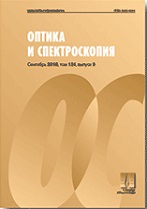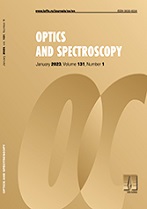|
Proceedings of the international conference ''The XXIV Annual Conference Saratov Fall Meeting 2020''
Biophotonics
Spectral manifestations of bacterially synthesized silver sulfide nanoparticles formation molecular mechanisms
I. L. Plastun, A. A. Zakharov, A. A. Naumov, P. A. Zhulidin, P. D. Filin
Yuri Gagarin State Technical University of Saratov
Abstract:
One of the promising materials for biophotonics and medicine, used for the diagnosis and targeted therapy of cancer, is silver sulfide nanoparticles. Spectral manifestations of protein structures interaction with metal salts during the nanoparticles bacterial synthesis molecular mechanisms are studied using molecular modeling methods based on the Density Functional Theory (DFT). A special feature of silver sulfide nanoparticles preparation by biosynthesis using Bacillus subtilis 168 bacteria is that the only flagellin protein involved in the synthesis process and adsorbed on particles surface. The studied objects were the salts-silver nitrate and sodium thiosulfate, which are involved in the synthesis process, as well as the non-standard amino acid methyllysine, which is part of flagellin. The simulation was based on the calculation of resulting molecular structures and their IR spectra using the Gaussian 09 software package. During the analysis of formed hydrogen bonds parameters, it was found that methyllysine forms sufficiently stable molecular complexes with silver nitrate and sodium thiosulfate. This indicates the significant role of methyllysine in biogenic silver sulfide nanoparticles formation and clarifies the mechanism of its functioning.
Keywords:
IR spectra, nanoparticles, biosynthesis, silver sulfide, flagellin, methyllysine, molecular modeling, hydrogen bonds, density functional theory.
Received: 05.01.2021
Revised: 12.02.2021
Accepted: 26.02.2021
Citation:
I. L. Plastun, A. A. Zakharov, A. A. Naumov, P. A. Zhulidin, P. D. Filin, “Spectral manifestations of bacterially synthesized silver sulfide nanoparticles formation molecular mechanisms”, Optics and Spectroscopy, 129:6 (2021), 717–726; Optics and Spectroscopy, 129:7 (2021), 794–803
Linking options:
https://www.mathnet.ru/eng/os115 https://www.mathnet.ru/eng/os/v129/i6/p717
|


| Statistics & downloads: |
| Abstract page: | 64 | | Full-text PDF : | 13 |
|





 Contact us:
Contact us: Terms of Use
Terms of Use
 Registration to the website
Registration to the website Logotypes
Logotypes








 Citation in format
Citation in format 